
Helsinki is the capital, largest and most populous city in Finland. Located on the shore of the Gulf of Finland, it is the seat of the Uusimaa region in southern Finland. Approximately 0.67 million people live in the municipality, with 1.25 million in the capital region, and 1.64 million in the metropolitan area. The region is by far the most populous urban area in Finland and the country's most important centre for politics, education, finance, culture and research. Helsinki is located 80 kilometres (50 mi) north of Tallinn, Estonia, 362 km north of Riga, Latvia 400 km (250 mi) east of Stockholm, Sweden, and 300 km (190 mi) west of Saint Petersburg, Russia. It has close historical links with these four cities.

The Newport Ship is a mid-fifteenth-century sailing vessel discovered by archaeologists in June 2002 in the city of Newport, South East Wales. It was found on the west bank of the River Usk, which runs through the city centre, during the building of the Riverfront Arts Centre; from which process it sustained some damage. The official name of the vessel is now the Newport Medieval Ship, to help distinguish it from other historical vessels.

Finnish cuisine is notable for generally combining traditional country fare and haute cuisine with contemporary continental-style cooking. Fish and meat play a prominent role in traditional Finnish dishes in some parts of the country, while the dishes elsewhere have traditionally included various vegetables and mushrooms. Evacuees from Karelia contributed to foods in other parts of Finland in the aftermath of the Continuation War.

Kalakukko is a traditional Finnish dish from the region of Savonia made from fish baked inside a loaf of bread. Kalakukko is especially popular in Kuopio, capital city of the Northern Savonia region. Kuopio is home to many kalakukko bakeries. The city also hosts an annual kalakukko baking contest.
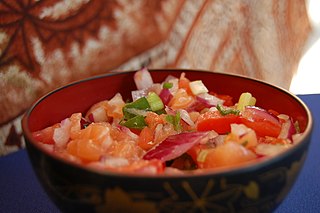
Lomi lomi salmon is a side dish in Hawaiian cuisine containing salted salmon, onions, and tomatoes. Its origin is similar to poisson cru. It also resembles pico de gallo in appearance and to how it is often consumed as an accompaniment to other foods such as poi or kalua pork.
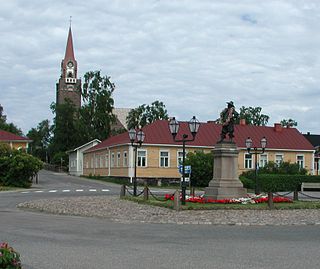
Raahe is a town and municipality of Finland. Founded by Swedish statesman and Governor General of Finland Count Per Brahe the Younger in 1649, it is one of 10 historic wooden towns remaining in Finland. Examples of other Finnish historic wooden towns are Kaskinen (Kaskö), Old Rauma, Porvoo (Borgå), Jakobstad (Pietarsaari), and Vaasa (Vasa). After a devastating fire in 1810, Raahe was rebuilt adhering to new design principles which minimized the risk of fire and enlarged some civic spaces. Old Raahe is noted for its Renaissance-inspired rectilinear town plan featuring an unusual central-square with closed corners.
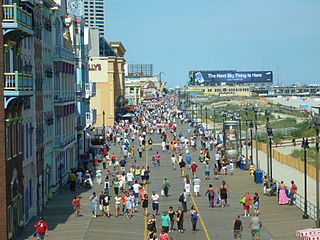
A boardwalk is an elevated footpath, walkway, or causeway typically built with wooden planks, which functions as a type of low water bridge or small viaduct that enables pedestrians to better cross wet, muddy or marshy lands. Such timber trackways have existed since at least Neolithic times.

A sewn boat is a type of wooden boat which is clinker built with its planks sewn, stitched, tied, or bound together with tendons or flexible wood, such as roots and willow branches. Sewn boat construction techniques were used in many parts of the world prior to the development of metal fasteners, and continued to be used long after that time for small boats to reduce construction costs where metal fasteners were too expensive.

A treenail, also trenail, trennel, or trunnel, is a wooden peg, pin, or dowel used to fasten pieces of wood together, especially in timber frames, covered bridges, wooden shipbuilding and boat building. It is driven into a hole bored through two pieces of structural wood.

Indirect grilling is a barbecue cooking technique in which the food is placed to the side of or above the heat source instead of directly over the flame as is more common. This can be achieved by igniting only some burners on a gas barbecue or by piling coals to one side of a charcoal pit. A drip tray is placed below the food to prevent fat from the food igniting and generating a direct flame. Indirect grilling is designed to cook larger or tougher foods that would burn if cooked using a direct flame. This method of cooking generates a more moderate temperature and allows for an easier introduction of wood smoke for flavoring.

The shikara is a type of wooden boat found on Dal Lake and other water bodies of Srinagar in Jammu and Kashmir. Shikaras are of various sizes and are used for multiple purposes, including transportation. A usual shikara seats six people, with the driver paddling at the rear. Like the Venetian gondolas, they are a cultural symbol of Kashmir. Some shikaras are still used for fishing, harvesting aquatic vegetation, and transport, while most are covered with tarpaulins and are used by tourists. A Shikara ride in Dal Lake is a great way to experience the beauty of Dal Lake and get a glimpse into the life of the locals. Some are used as floating homes.

The food of the Tlingit people, an indigenous group of people from Alaska, British Columbia, and the Yukon, is a central part of Tlingit culture, and the land is an abundant provider. A saying amongst the Tlingit is that "When the tide goes out the table is set." This refers to the richness of intertidal life found on the beaches of Southeast Alaska, most of which can be harvested for food. Another saying is that "in Lingít Aaní you have to be an idiot to starve". Since food is so easy to gather from the beaches, a person who cannot feed himself at least enough to stay alive is considered a fool, perhaps mentally incompetent or suffering from very bad luck. Though eating off the beach could provide a fairly healthy and varied diet, eating nothing but "beach food" is considered contemptible among the Tlingit, and a sign of poverty. Shamans and their families were required to abstain from all food gathered from the beach, and men might avoid eating beach food before battles or strenuous activities in the belief that it would weaken them spiritually and perhaps physically as well. Thus for both spiritual reasons as well as to add some variety to the diet, the Tlingit harvest many other resources for food besides what they easily find outside their front doors. No other food resource receives as much emphasis as salmon; however, seal and game are both close seconds.

Pacific Northwest cuisine is a North American cuisine that is found in the Pacific Northwest, i.e. the states of Oregon, Washington, Idaho and Alaska, as well as the province of British Columbia and the southern portion of the territory of Yukon, reflecting the ethnic makeup of the region, with noticeable influence from Asian and Native American traditions. With significant migration from other regions of the US, influences from Southern cuisine brought by African Americans as well as Mexican-American cuisine as Latinos migrate north from California, can be seen as well.
Ancient boat building methods can be categorized as one of hide, log, sewn, lashed-plank, clinker, shell-first, and frame-first. While the frame-first technique dominates the modern ship construction industry, the ancients relied primarily on the other techniques to build their watercraft. In many cases, these techniques were very labor-intensive and/or inefficient in their use of raw materials. Regardless of differences in ship construction techniques, the vessels of the ancient world, particularly those that plied the waters of the Mediterranean Sea and the islands of Southeast Asia were seaworthy craft, capable of allowing people to engage in large-scale maritime trade.

C. A. Nothnagle Log House, also known as Braman-Nothnagle Log House, is a historic house on Swedesboro-Paulsboro Road in Gibbstown, New Jersey and is one of the oldest log houses in the United States.
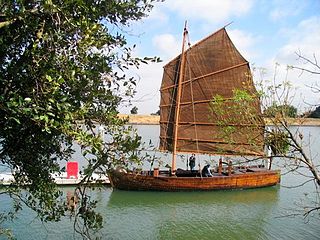
Grace Quan is a modern reconstruction of a Chinese-American shrimp fishing junk, similar to those in the fleet that operated in San Francisco Bay in the late 19th and early 20th centuries. The junk was built in 2003 as a joint project between China Camp State Park in San Rafael, California and the San Francisco Maritime National Historical Park, and is now jointly exhibited and operated by both institutions. It functions as a "working sailing museum" to educate the public about a previously forgotten chapter in the history of Chinese-American immigrants to California.

Calumet Fisheries is a seafood restaurant in the South Deering neighborhood of Chicago, Illinois, United States, directly next to the 95th Street bridge. It was originally established in 1928, and subsequently purchased in 1948 by Sid Kotlick and Len Toll. It serves smoked and fried fish, shrimp, and clams. The restaurant is often featured on TV shows and web series', such as Eater's Dining on a Dime and Anthony Bourdain: No Reservations. The building is a one-room shack with a counter and no seating. Patrons can take their food to go, or sit in their parked cars along 95th Street to eat.

Yup'ik cuisine refers to the Eskimo style traditional subsistence food and cuisine of the Yup'ik people from the western and southwestern Alaska. Also known as Cup'ik cuisine for the Chevak Cup'ik dialect speaking Eskimos of Chevak and Cup'ig cuisine for the Nunivak Cup'ig dialect speaking Eskimos of Nunivak Island. This cuisine is traditionally based on meat from fish, birds, sea and land mammals, and normally contains high levels of protein. Subsistence foods are generally considered by many to be nutritionally superior superfoods. Yup’ik diet is different from Alaskan Inupiat, Canadian Inuit, and Greenlandic diets. Fish as food are primary food for Yup'ik Eskimos. Both food and fish called neqa in Yup'ik. Food preparation techniques are fermentation and cooking, also uncooked raw. Cooking methods are baking, roasting, barbecuing, frying, smoking, boiling, and steaming. Food preservation methods are mostly drying and less often frozen. Dried fish is usually eaten with seal oil. The ulu or fan-shaped knife is used for cutting up fish, meat, food, and such.
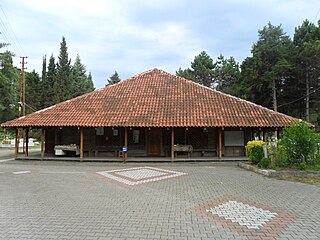
Göğceli Mosque is a historic log mosque situated inside the Göğceli Cemetery in Çarşamba, Samsun, northern Turkey. Built during the Seljuk Empire period in the 13th century, the log mosque was constructed without the use of nails.



















